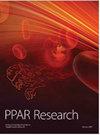贝扎菲特减轻压力超载引起的心脏肥大和纤维化
IF 3.5
3区 医学
Q2 MEDICINE, RESEARCH & EXPERIMENTAL
引用次数: 19
摘要
背景。过氧化物酶体增殖物激活受体-α (PPAR-α)与心肌肥厚的发生密切相关。先前的研究表明,苯扎贝特(BZA)是一种PPAR-α激动剂,可以减轻胰岛素抵抗和肥胖。本研究旨在确定BZA是否对压力过载引起的心脏肥厚具有保护作用。方法。从主动脉束带术后1周开始,小鼠口服BZA (100 mg/kg) 7周。基于超声心动图、组织学和分子方面评估心脏肥厚。此外,我们在体外用新生大鼠心室心肌细胞(nrvm)研究BZA对心肌细胞肥厚反应的影响。结果。我们的研究表明,BZA可以减轻AB手术小鼠的心脏肥大和纤维化。BZA还降低了蛋白激酶B (AKT)/糖原合成酶激酶3β (GSK3β)和丝裂原活化蛋白激酶(MAPKs)的磷酸化水平。BZA对苯肾上腺素(PE)诱导的心肌细胞肥大有抑制作用。体外PPAR-α拮抗剂可使BZA的保护作用消失。结论。BZA可减轻压力过载引起的心肌肥大和纤维化。本文章由计算机程序翻译,如有差异,请以英文原文为准。
Bezafibrate Attenuates Pressure Overload-Induced Cardiac Hypertrophy and Fibrosis
Background. Peroxisome proliferator-activated receptor-α (PPAR-α) is closely associated with the development of cardiac hypertrophy. Previous studies have indicated that bezafibrate (BZA), a PPAR-α agonist, could attenuate insulin resistance and obesity. This study was designed to determine whether BZA could protect against pressure overload-induced cardiac hypertrophy. Methods. Mice were orally given BZA (100 mg/kg) for 7 weeks beginning 1 week after aortic banding (AB) surgery. Cardiac hypertrophy was assessed based on echocardiographic, histological, and molecular aspects. Moreover, neonatal rat ventricular cardiomyocytes (NRVMs) were used to investigate the effects of BZA on the cardiomyocyte hypertrophic response in vitro. Results. Our study demonstrated that BZA could alleviate cardiac hypertrophy and fibrosis in mice subjected to AB surgery. BZA treatment also reduced the phosphorylation of protein kinase B (AKT)/glycogen synthase kinase-3β (GSK3β) and mitogen-activated protein kinases (MAPKs). BZA suppressed phenylephrine- (PE-) induced hypertrophy of cardiomyocyte in vitro. The protective effects of BZA were abolished by the treatment of the PPAR-α antagonist in vitro. Conclusions. BZA could attenuate pressure overload-induced cardiac hypertrophy and fibrosis.
求助全文
通过发布文献求助,成功后即可免费获取论文全文。
去求助
来源期刊

PPAR Research
MEDICINE, RESEARCH & EXPERIMENTAL-
CiteScore
6.20
自引率
3.40%
发文量
17
审稿时长
12 months
期刊介绍:
PPAR Research is a peer-reviewed, Open Access journal that publishes original research and review articles on advances in basic research focusing on mechanisms involved in the activation of peroxisome proliferator-activated receptors (PPARs), as well as their role in the regulation of cellular differentiation, development, energy homeostasis and metabolic function. The journal also welcomes preclinical and clinical trials of drugs that can modulate PPAR activity, with a view to treating chronic diseases and disorders such as dyslipidemia, diabetes, adipocyte differentiation, inflammation, cancer, lung diseases, neurodegenerative disorders, and obesity.
 求助内容:
求助内容: 应助结果提醒方式:
应助结果提醒方式:


